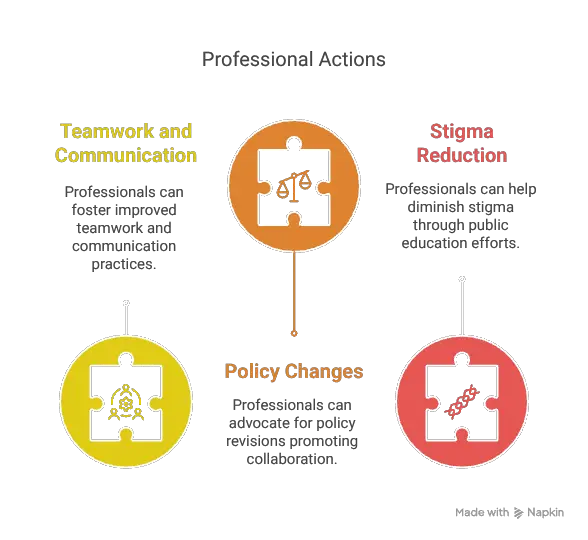
How to Adopt Multidisciplinary Approaches for Disability Support
Disability support has evolved considerably over the years. From only isolated treatments, it has become a holistic approach involving professionals from multiple disciplines. This multidisciplinary approach manages the needs of people with disabilities, covering medical and psychological requirements with educational and social needs.
The prime advantage of such support is individualized, all-encompassing care. A multidisciplinary strategy does not target only the symptoms. Instead, it stresses a more comprehensive support system – one that helps medical science and technology advancements reach more people.
✅ Key Takeaways: Multidisciplinary Disability Support
| Topic | Key Point |
|---|---|
| What is it? | A holistic support approach involving medical, mental health, education, and social care professionals. |
| Why it matters | Offers personalized, well-rounded care that meets physical, emotional, social, and learning needs. |
| Medical Support | Doctors, therapists, and assistive tech help people regain independence and manage health conditions. |
| Mental Health Support | Therapists and counsellors use CBT and emotional support to improve mental wellbeing. |
| Educational Support | Special educators create IEPs and inclusive classrooms using adaptive tools and resources. |
| Challenges | Main issues include lack of funding and poor coordination between professionals. |
| Solutions | Advocate for funding, improve teamwork, and educate others to reduce stigma. |
| Who it’s for | Ideal for healthcare workers, teachers, social workers, caregivers, and disability advocates. |
As a social work or education professional, you can apply this framework to support people with disabilities. Let us discuss the various disciplines involved in this approach. We will also assess the challenges you may face in its implementation.
Understanding Disability Support
The numbers from the CDC show how serious this issue is: almost 1 in 4 adults in the US lives with some form of disability. That’s why it’s important for professionals to know how to support them.
- Physical challenges: Problems like losing a limb or being paralyzed. Over 12% of Americans have a mobility issue.
- Intellectual disabilities: These affect thinking and decision-making. Around 14% of adults face these challenges. This includes conditions like major depressive disorder and post-traumatic stress disorder as listed under the Americans with Disabilities Act.
- Sensory issues: Trouble seeing or hearing. Older adults especially may have these. A study shows that sensory problems often come with mental health struggles too.
- Developmental disabilities: Conditions like autism or Down syndrome, which can affect learning, emotions, and physical development from a young age.
Even though support has improved, many people still face stigma, money problems, and a lack of personalized care. According to the CDC, disabled adults are more likely to suffer from chronic health problems like heart disease and diabetes.
As a professional looking to contribute to this field, you must collaborate with the following teams:
Medical and Healthcare Support
This team is the first point of contact for someone facing a disability. Medical professionals will diagnose the condition. Accordingly, they will administer appropriate treatment.
This team may also recommend suitable rehabilitation therapies. For example, if the condition is physical, a doctor may ask the patient to use assistive devices like wheelchairs or prosthetics.
This team also depends on the contributions of physical/occupational therapists and healthcare social workers.
This company that offers NDIS occupation therapy services in Sydney adds that you can also support disability care by helping patients with follow-up care and routine health checkups. Regular monitoring ensures that treatments remain effective and that any emerging issues are addressed early. Encouraging patients to stay consistent with their medical appointments and assisting them in understanding their care plans strengthens long-term health outcomes
As a part of this team, here’s how you can actively work for disability support:
- Increase a patient’s autonomy
Therapists work with medical teams to help people regain coordination and motor skills for everyday living. Their primary role is in boosting mobility and independence, helping people adjust to changed realities.
For example, patients recovering from a severe stroke may feel one-sided weakness. They may struggle with gripping things. A therapist can help them understand how to use a mobility aid like Active Hands to feel confident enough to handle routine tasks like cooking or dressing.
- Offer emotional support and guidance
Healthcare social workers also play a crucial role in supporting individuals with disabilities. Their job requires empathy and thoughtfulness, as important as routine medical care.
Marymount University notes that these professionals help people manage complicated health challenges through companionship and emotional support. They also support caregivers by sharing expert guidance on best practices and providing counselling. They also connect them to additional healthcare resources.
If you are keen to pursue this field, you should consider a relevant degree like a Bachelor of Social Work or an MSW program online or offline. These courses can help you learn to address the medical and emotional challenges of individuals with disabilities. You will learn to work intimately with doctors and therapists.
Mental Health and Psychological Support

Mental health support is a core component of the multidisciplinary approach, not surprising in our stressful world. Living with a disability can substantially lower emotional and psychological well-being. Psychiatrists or counsellors use specialised therapy to mitigate such challenges.
As a professional, you can take up the following approaches for disability support in this field:
- Cognitive-behavioral therapy
CBT first became popular as a treatment for depression and anxiety. It has also proved beneficial for individuals with developmental disorders. Over time, it can help people develop social skills and regulate emotions. They can also improve adaptive behaviors.
For example, a Wiley Online Library study assessed students with intellectual disabilities. Over 12 sessions of behavioral activation therapy, the students felt reduced depression and anxiety. It suggests that professionals can use behavioral activation therapy to address emotional challenges in this population.
Several Redditors report success with CBT, saying it helped cope with debilitating depression and anxiety.
If you have deeper issues, CBT may just be the first step giving you the peace of mind you need to go deeper and start trying to address why the thoughts are happening in the first place.
- Specialized support and counseling services
It is another area professionals in this team can focus on. Besides people with conditions like ADHD or intellectual disabilities, such support can help families. The caregivers understand how to help their loved ones better – being supportive but not patronizing.
For instance, a well-intentioned caregiver may believe constant activity and pressure to keep going will boost recovery. However, such intervention may discourage a struggling adult and further lower their self-confidence. Family counseling can help caregivers understand the value of rest in recovery.
Educational Support
Another core constituent of multidisciplinary teams is special education instructors and learning support workers. They help students with disabilities access tailored learning environments to reach their full potential and not let their health issues restrict them.
As a professional in this field, you will need to develop competence in the following areas:
- Create and implement individualized education plans
A multidisciplinary evaluation team examines the student’s abilities to determine their eligibility for special education. As a team member, you will do this in collaboration with the parents.
Accordingly, you will create IEPs with the necessary modifications to support the student’s academic and social success. These plans are a roadmap with personalized goals that address every student’s unique requirements.
The US-based Weinfeld Education Group, which works with children with disabilities, recommends close family and educator involvement. Its founder, Rich Weinfeld, says that interventions need evidence-based data. The team must examine which interventions have worked under what circumstances.
A mum on Reddit shared how an IEP benefitted her daughter, who struggles with bipolar disorder and depression. [Source: Reddit r/daddit]
She is in both special education and non-special ed classes. Participating in non-special ed classes has allowed her to gain confidence and work on her social anxiety.
- Build an inclusive classroom environment
While implementing IEPs, professionals focus on creating an inclusive educational environment. Children with disabilities should feel able to pursue their studies with peers. Accordingly, you will build support programs that uphold inclusivity and accessibility.
- Use resources like Braille materials, speech-to-text software, and adaptive classroom technologies.
- Facilitate access to tools like the Functionalhand to improve grip for students with poor hand function. Specially designed art and craft tools like scissors with oversized loop handles can help students with motor skill limitations.
- Advocate for government funding and support
To fulfill the above two goals, professionals usually require government support.
For example, many parents of children with special needs in Ohio emphasize the role of the US Department of Education in enforcing federal protections for all students. The Ohio Capital Journal reports that these parents demand federal supervision to ensure their children get equitable educational opportunities.
The mettle to stand up for disability rights is more urgent in light of distressing recent developments, like the UK’s proposed benefit cuts. Deven Ghelani, the director of consultancy firm Policy in Practice, says this move could make many people invisible as their support cost will pass to other agencies.
Consequently, professionals must develop patient advocacy skills to champion programs to support educational and other needs.
Challenges in Implementing Multidisciplinary Disability Support
While a multidisciplinary approach to healthcare has far-reaching benefits, it remains ridden with challenges. A social or education worker may face many problems when implementing this approach.
- Limited funding and insufficient resources
- The problem: Inadequate funds and resources complicate access to various services for people with disabilities. They may face long wait times and struggle to afford emerging programs that can improve their condition.
- What professionals can do:
- Advocate for your patients to receive disability grants where applicable. These grants give financial assistance to individuals and organizations supporting them.
- Help patients receive financial aid for services like assistive technology and vocational training.
- Spread awareness of the need to increase funding for multidisciplinary collaboration and accessibility. Social media and public events can be helpful here.
- Lack of coordination among professionals
- The problem: Communication gaps between team members, such as healthcare providers and social workers, hinder collaboration. Coordination issues also aggravate other preexisting challenges and social barriers like stigma.
A Reddit user shared their frustration about poorly coordinated multidisciplinary team meetings that go nowhere. [Source: Reddit r/nhs]
I never know who to go to talk about symptoms and in years of going through this and being bounced from specialist to specialist I feel like I have gotten very few answers.
What professionals can do:

-
- Encourage better teamwork and communication.
- Advocate for policy changes that support collaboration.
- Help break down stigma by educating the public.
Our world continues to advance in technology and inclusivity, improving the quality of life for those with disabilities. Multidisciplinary frameworks will be vital in substantiating support in the future.
For passionate professionals dedicated to building a more equitable and compassionate society, such collective effort can reap excellent results. When different disciplines converge, care can become transformative.